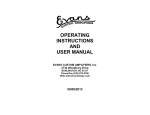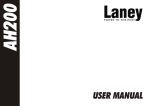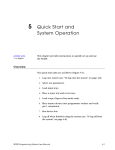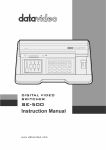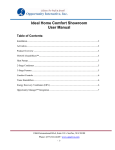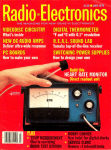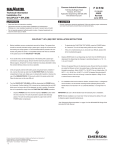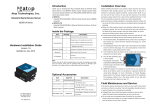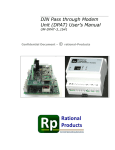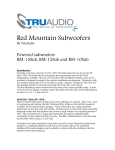Download 8 - Evans Custom Amplifiers
Transcript
OPERATING INSTRUCTIONS AND USER MANUAL EVANS CUSTOM AMPLIFIERS, Inc. 2734 Woodbury Drive BURLINGTON, NC 27217 Phone/Fax (336) 270-5700 Web www.EvansAmps.com 04/01/2013 Congratulations, you have just acquired the finest in musical instrument amplification. Starting in 1962, Evans has been building amplifiers exhibiting the ultimate in sound reproduction tonal quality. The founder of our company, Jim Evans, was a professional steel guitar player as well as an industrial electronics engineer who recognized that no amplifier on the market filled the exacting need for quality of tone and complete control of the tonal profile. He started building amplifiers for his own use. A few weeks would go by until another musician would make him an offer for his amp. After letting the amp go that night, he furiously worked to build another so he could play that weekend. Thus began our company. Through the years, the electronic design has been refined with new technology being embraced at every opportunity. Whether you play jazz guitar, steel guitar, finger style, rhythm or lead guitar, fiddle or keyboard, Evans will give you a tonal quality that is beyond compare. Scot and Julia Buffington OPERATING INSTRUCTIONS Evans amplifiers are designed to reproduce the true sound of your instrument. You will find the controls easy to adjust by using the following outline to get you started. You may use the entire span of the control if necessary. For instance, there is no rule that says you must have the Reverb control at 6 or Bass at 3. Make use of all the controls and inputs to achieve the sound you want. Here are a few tips we have learned from our customers over the years. NORMAL AND +6db INPUTS: +6db provides the most volume with a heavier amplified sound. Use the NORMAL input with strong pickups to avoid overdriving the preamp. MASTER: Used to set the output gain of the preamp. The convenient ON/OFF switch is activated when this control is rotated CW. Since the switch activates between 2 and 3, the part of the rotation between 3 and 10 is used for level control. BUFF: This control provides beautiful overtones for the solid-state preamp usually only found in tube preamps. Start with BUFF on 4-6, next adjust TREBLE and EXPAND. REVERB: Adjusts the mix of reverb and bypass signal to give the degree of reverb desired. For very wet reverb, place REVERB at maximum. BASS: The maximum BASS is dialed in by playing the lowest open string while turning the control CW from 0 until it gets boomy. Then back off by a number. Turn down BASS when using +6db INPUT with MASTER greater than 6 or NORMAL INPUT with MASTER greater than 7. Remember, the louder you play, the less BASS you need. If the BASS is turned up at loud volumes, the low end will be over compensated and muddy because bass frequencies are easier to reproduce at loud volumes. DEPTH: This control enhances the low and low mid-range. CCW is off. Turn to 70% or so. BODY control should be greater than 1 for this control to be effective. BODY: Used to set the mid range and darkness of the sound. This is a multifunction control that increases low midrange tones while rolling off high frequencies. EXPAND: This knob boosts the highs and some low tones. TREBLE: Sets the amount of treble desired. Playing the highest open string and turning up the control from 0 until it gets thin and then backing off a number should find maximum TREBLE. VOLUME: Sets the input level to the preamp. Lower settings mimic the instrument’s voice;; higher, settings (6-9) emphasize the amplifier’s tone settings. EFFECTS SEND AND RETURN: These jacks are located on the back panel of the preamplifier. In the signal path, they are situated after all tone controls and addition of internal REVERB. Most effects units should be connected here. However, some effects may operate better connected between the instrument and NORMAL input. PREAMP OUT: This is an unbalanced line out signal for driving a mixer board or an additional power amplifier. Lev el is independent of MASTER control. EXTERNAL SPEAKER: The output is used for driving an external 8 ohm speaker. For the AH200, the combined load of speakers should not be less than 4 ohms. PHONES: Jack designed for stereo headphones, 40 Ohm impedance nominal. When phones are plugged in, all speakers are switched off. GENERAL SETUP Use settings below and add DEPTH and EXPAND to taste*. MASTER REVERB BASS BODY TREBLE VOLUME INPUT RE200 / RE500** 10“ SPEAKER 4-6 4-6 3-5 3 4 2 5 5 2 6 7 3 5 2 2 4-6 5-7 3-5 +6db NORMAL NORMAL JE200 / JE500** 12” SPEAKER 3-4 3-5 3-5 2 3-4 3 0-1 5 4 3.5 6 7-9 0-2 4 3 3-4 3-5 6-9 NORMAL +6db NORMAL SE200 / SE500** 15” SPEAKER 3-4 4-5 4-6 5 4 4-6 1-3 5 1-3 6-8 6 3 2 4 2 5-7 3-5 3-4 NORMAL +6db NORMAL REVERB SELECTION: The rear panel contains a selector switch and a variable DWELL control that sets reverb parameters. The switch selects one of three reverbs: Reverb alone, Reverb plus Flange and Reverb plus Chorus. The dwell control sets room size or reverb interval. The dwell control has a convenient center detent value sufficient for most musicians. The interval or dwell variation is as follows: REVERB - DWELL = 0.5 to 5.25 sec. REVERB PLUS FLANGE - DWELL = 5.9 to 0.31 Hz / 1 to 3 sec. REVERB PLUS CHORUS - DWELL= 5.9 to 0.31 Hz / 1 to 3 sec. Buzz Evans’ secret reverb setting for tube response: Switch to Reverb + Flange with Dwell CW just past center detent. NOTE: Flange is achieved by splitting the audio signal into two paths and introducing a variable phase shift in one path before recombining the signal. The chorus effect is similar except the delay introduced is rapid and random. * For the AH200 use suggested settings according to the speaker size. **Use the lower Volume and Master settings for the 500 Watt Amps. TROUBLE CHECKS Sometimes, checking a few basic things can solve problems. To save time and money, please check the troubleshooting tips below before you call for help or ship your amp back to us for repair. If repair should be necessary and the amplifier is under warranty, we prefer it to be sent to us for evaluation and repair. No Power If pilot light on the preamp is out, first check the power cord and cord connections. For console amplifiers, check the 28 Vac connections from the power amplifier to the rear of the preamp. No Sound No sound from the speaker although the pilot light is on. First, unplug any external speaker then reset the power amplifier by turning off power, wait a few seconds for the pilot light to go out, and then turn the power back on. If the sound returns, check the external speaker and cord for shorts. Next, check with stereo headphones for sound. If the headphones are working then check internal speaker and wiring. If there is no sound in the headphones, use a Digital Multi-Meter to check the 10K ohm Master potentiometer. If the pot checks good, insert a known good guitar cord into the send and return jacks, if the amp now works clean or replace your effects loop jacks. Hum and Other Interference Check guitar signal cord or effects cords for open shield connection. Check the output jack on guitar for broken ground or signal connection. Check room light dimmer circuits as source of radiated hum. Do not place cell phones on the amplifier. Keep single-coil pickups a reasonable distance from the amp. Amp Volume Fluctuates You may need to clean the 1\4" jacks by plugging and unplugging a guitar cord into them (the effects send and return, +6db and normal jacks). You may also need to spray one spray of a non residue fast drying electronics cleaner into each jack then plug into and out of each jack. The contacts inside of the jacks may have gotten oxidation on them. Also, you could try jumping out the effects loop. To do this plug a known good guitar cable into the effects send and return jacks. If this fixes the problem, then clean or replace the effects jacks. Amp Cuts Out Your power amp may be protecting itself from damage that can result from loud distortion or tone settings that are not optimized for your required application. Another possibility is a loose connection, so call us directly after rereading the owner's manual. Need Amp Repair Please give us your phone number and best times to call along with the serial numbers on the preamp and power amp so that we can better assist you. We will be glad to help you by phone. Note: There are no user serviceable parts inside the chassis. Only a qualified service technician can properly determine the course of action beyond the above checks. DPU200 and AH200 Digital Power Unit The DPU200 and AH200 contain a digital power amplifier providing a maximum output of 200 Watts into 4 ohms. In addition, there is a transformer to supply the 28Vac for the preamplifier. Power Module The output is bridged and not referenced to common or circuit ground. Therefore, connect only a speaker load. Any other load or appliance that causes output current to flow to ground will cause the amplifier to permanently fail. If the output leads are shorted together, the amplifier may recover from the fault by removing the load and turning the amplifier off for several seconds. If the condition that caused the fault has been removed, proper operation of the amplifier will be restored. Transformer The preamp supply transformer is configured with dual windings so you may operate the entire unit from nominal voltages of 115 to 230 Vac by using the selector switch (units intended for Japan are not capable of this switching). Never operate this unit on 230 Vac with the switch in the 115 Vac position. To configure this unit for a different voltage, you must either procure a plug adaptor or attach the proper plug to the power cord. WARRANTY Evans Custom Amplifiers warrants this product to be free from defects in material and workmanship for a period of three years from the date of delivery to the original consumer purchaser. Evans Custom Amplifiers will pay all labor and material expenses for all repairs covered by this warranty. The Buyer is responsible for arranging its transportation for repair, risk of transport and payment of any shipping charges. In addition, proof of date of purchase may be necessary in order to obtain warranty repair. All shipping, risk of transport, and cost of repair and/or replacement work of any product made AFTER the above stated warranty period shall be the responsibility of the Buyer. Sales outside the US are sold as-is, without warranty. However, Evans will supply any parts deemed necessary by Evans for repair at a nominal cost not includi ng shipping. This warranty does not apply to any product damaged by accident, misuse, abuse, improper voltage, product modification, neglect, faulty installation or operation, improper maintenance, rental or any shipping damage, lightning (or other acts of God). This warranty does not apply to any parts for service by anyone else other than Evans Custom Amplifiers or their authorized service technician. This warranty is in lieu of all other warranties expressed or implied, and Evans Custom Amplifiers makes no further warranties expressed or implied including, but not so limited, any warranties of merchantability or fitness for any particular purpose. It is expressly agreed that the Buyer / User shall have no claim against Evans Custom Amplifiers with respect to either personal injury or damage to property or loss of profit resulting from any defect or for any consequential damages, such as, but not so limited, loss of business opportunities, property or personal injury losses, etc. or for any indemnity, implied or expressed, with respect to claims by third parties, And Buyer shall indemnify Evans Custom Amplifiers against any and all claims by third parties against Evans Custom Amplifiers resulting from the use of equipment and/or materials purchased hereunder or from the use of any products made from or by said equipment or materials. These terms and conditions take precedent over all other terms and conditions, warranty statements or policies.







